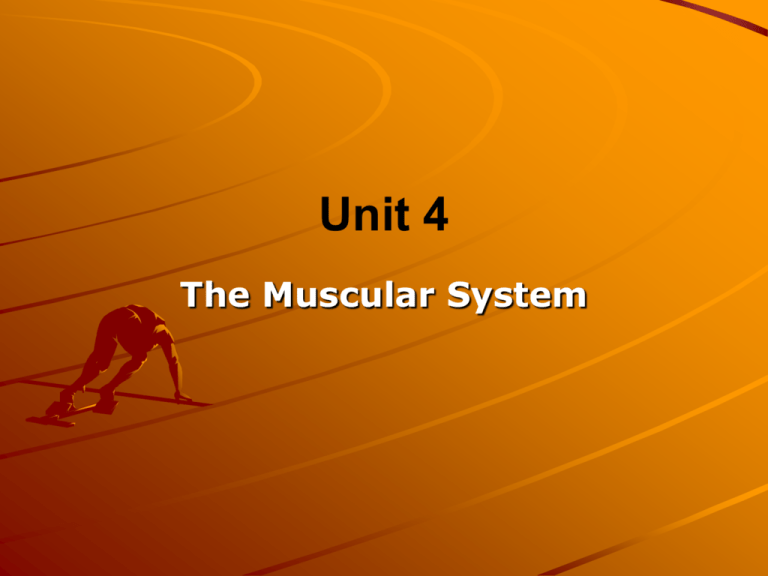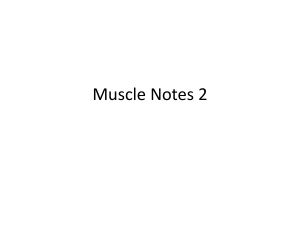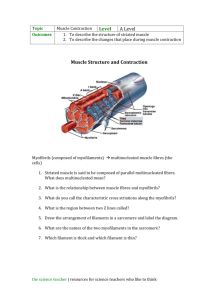Muscles
advertisement

Unit 4 The Muscular System Muscle Cells There are 3 types of muscle cells – Cardiac, Smooth, and Skeletal All muscles can contract (shorten) When muscles contract, part of the body moves Cardiac Muscles Striated, tubular, and branched Have one nucleus per cell Contract involuntarily Found in the walls of the heart Smooth Muscles Non-striated, arranged in sheets Have one nucleus per cell Contract involuntarily, and can sustain prolonged contractions Smooth Muscles Found in the walls of internal organs (cavities and tubes) such as: – Blood vessels, iris of the eye, internal organs such as the stomach, intestines, uterus, and esophagus for peristalsis Skeletal Muscles Striated and tubular Have many nuclei per cell Attached to the bones of the skeleton Skeletal Muscles Contract voluntarily, controlled consciously by the nervous system Due to structure and having many nuclei they are referred to as fibres Compare the muscle types! Type Cardiac Smooth Skeletal Structure Voluntary/ Location Involuntary? in the Body Type Structure Voluntary/ Involuntary ? Location in the Body Cardiac Tubular, arranged in a branched network, striated, one nucleus per cell involuntary Heart Smooth Long, tapered, arranged in sheets, nonstriated, one nucleus per cell involuntary Walls of digestive system, blood vessels, other internal organs Skeletal Tubular, very long, voluntary striated, many Attached to the bones of nuclei per cell. the skeleton, Muscle Contraction Muscles contract they shorten! Muscles can only pull they cannot push Muscles that permit movement are found in pairs, as each muscle in the relaxed state needs an opposite muscle to stretch it. Antagonistic muscles- pairs of muscles that work against each other to make a joint move Muscle contraction – bundle of fibres Skeletal muscles consist of many bundled muscle fibres held together with connective tissue Muscle fibre consists of: – Myofilaments a thread of contractile proteins found within muscle fibres Muscle Contraction bundles of fibres Two types of Myofilaments – Thick filament – fine myofilament composed of bundles of protein called myosin. Each myosin molecule consists of two polypeptide chains wrapped around each other. Binds to actin Two types of Myofilaments Thin filament – fine myofilament composed of strands of protein called actin. Consist of globular actin proteins. Binds to myosin Myofilament Contraction Four steps: 1. The myosin head is attached to actin Myofilament Contraction 2. The myosin head flexes, advancing the actin filament Myofilament Contraction 3. The myosin head releases and unflexes, powered by ATP. Myofilament Contraction 4. The myosin reattaches to actin farther along the fibre Sliding Filament Model Actin is anchored in the striated muscle tissue called the Z-Line Since it is ‘anchored’ like this, when actin moves it drags the Zline with it, toward the myosin This causes the entire muscle to contract Sliding Filament Model The heads of the two ends of the myosin filament are orientated in opposite directions. When the heads attach to the actin, they bend toward the centre of the myosin. Sliding Filament Model As one end of the myosin filament draws the actin filament and its attached Z line toward the centre, the other end of the myosin filament does the same Sliding Filament Model Both Z lines move toward the centre, and contraction occurs









